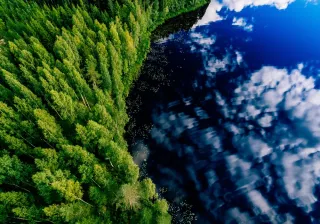There have been active discussions on increasing the value added by the forest industry for years. However, the discussions have widely overlooked a major untapped stream of raw material – biogenic carbon dioxide. The Natural Resources Institute Finland (Luke) and VTT Technical Research Centre of Finland estimate that the capture, storage and utilisation of biogenic carbon dioxide could significantly increase the value added by the forest sector for the national economy.
In their recent initiative, ‘From emitter to producer –
value added for the Finnish forest sector from carbon dioxide economy’, Luke and VTT assess which economic impacts the capture, utilisation and storage of the 20 million tonnes of biogenic carbon dioxide produced annually by the forest industry could have on Finland by 2040.
The value added per processed cubic metre of wood from the forest sector to the national economy has decreased significantly in recent decades.
"The carbon dioxide economy would be one way to improve resource efficiency in the forest sector and increase its value added without increasing felling volumes," says Jani Lehto, Luke’s Vice President of Bioeconomy and Environment.
"The transition to the carbon dioxide economy would involve the utilisation of biogenic carbon dioxide generated by the forest industry either as a raw material for further processing or its storage in the soil or as permanent carbon-binding products", states Antti Arasto, VTT's Vice President of Industrial Energy and Hydrogen.
Four scenarios towards a carbon dioxide economy
Luke and VTT studied the impact of the carbon dioxide economy on the value added for the national economy by 2040 in four different scenarios in which carbon dioxide is utilised in products and stored permanently.
According to the scenario study, the utilisation and further processing of biogenic carbon dioxide with renewable hydrogen into products such as aviation fuels could increase the value added for the Finnish national economy by EUR 2.6 billion. As the profit margin of production increases, the value added could reach up to EUR 8.6 billion.
Finland is well placed to become the great power of carbon dioxide economy, as a large amount of biogenic carbon dioxide is available in the forest industry and, in the future, more renewable hydrogen will likely be produced in Finland, as well. In addition to these advantages, the EU regulations strongly steer its members towards using bio-based renewable fuels, including those made of biogenic carbon dioxide, in transport and industry, which guarantees product demand.
Based on the scenario study, storing biogenic carbon dioxide could add value of EUR 1.5 billion for the national economy. As compensation paid for storage increases, the value added could reach EUR 3.6 billion.
Finland needs ambitious climate policy and investments
At present, technology for the capture, storage and further processing of carbon dioxide is still very expensive and partly in development. The challenge for the coming years will be to make it technologically ready and financially viable. The development requires both regulatory steering and investments.
EU and national regulations, which will develop in the next few years, will strongly determine how profitable the option of capturing, storing and utilising biogenic carbon dioxide will be.
The scenario calculations by Luke and VTT show that the need for investments would rise to EUR 36 billion by 2040.
Based on the scenario study carried out by Luke and VTT, the carbon dioxide economy offers opportunities for adding value for the national economy, achieving climate targets and promoting circular economy. These goals are also promoted by Finland’s current government programme.
"The question is: do we actively promote the carbon dioxide economy in Finland, or do we passively watch its development? It would be a pity if Finland only developed into a source of raw materials for the hydrogen economy: we would produce clean electricity, green hydrogen and biogenic carbon dioxide, but refining them into products would take place elsewhere," says Jani Lehto from Luke.
"If we managed to develop technologies and services in Finland for the needs of the global transition, their value added for the national economy and their global carbon handprint would probably be highly significant," Antti Arasto from VTT sums up the idea.
Download VTT´s and Luke´s report "Päästäjästä tuottajaksi – Hiilidioksiditaloudella arvonlisää Suomen metsäsektorille" (in Finnish).





